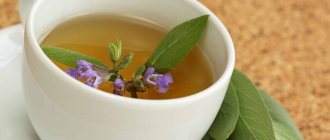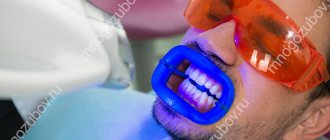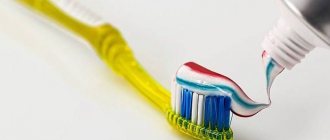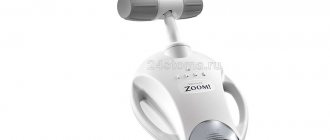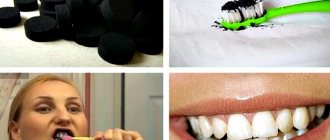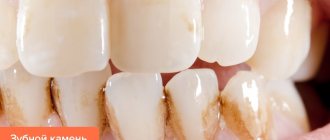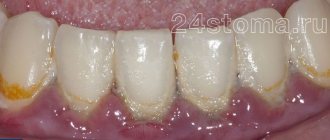01.12.2019
In order to figure out how to remove plaque on teeth after smoking, you need to understand the reasons for its formation. Smoking has a direct negative effect on the entire body and, in particular, contributes to the darkening of tooth enamel.
The best solution to the problem is to completely abandon this unhealthy habit. This will protect your health and preserve the natural whiteness of your teeth. If you really can’t quit smoking, then you can reduce the consequences for tooth enamel by regularly using special hygiene methods.
The true color of healthy teeth
The natural color of healthy teeth is rarely white. On the contrary, in normal condition they have a brown or yellow tint. A smile can have a yellow, gray, blue and even green tint, the main thing is to be able to distinguish a healthy color. The natural color of the enamel should match the shade of the sclera of the eye.
Healthy enamel is creamy or ivory in color. As it thins, the color of the teeth changes as more dentin becomes visible. This is bone substance, which is normally yellow. Throughout life, the color of teeth can change depending on a person’s habits.
Possible reasons for the change:
- bad habits;
- poor nutrition;
- removal of the nerve, as a result of which the tooth darkens from the inside;
- taking medications;
- acute, chronic diseases (jaundice, thyroid dysfunction);
- age-related changes;
- change in color of the filling;
- fluoride imbalance;
- fluorosis
Attempts to whiten teeth when the enamel is thinning can lead to a worsening of its condition. If a person has naturally yellowish teeth, whitening is not recommended, since the process damages the protective layer and increases the risk of caries.
Possible oral diseases in smokers
Long-term daily smoking of cigarettes contributes to the occurrence of the following pathological conditions:
- Dark coating. Smoking contributes to the formation of dark brown plaque on the teeth, which cannot be removed on your own. The problem is associated with the deposition of cadmium sulfate on the teeth, which is part of tobacco smoke.
- Gingivitis. An inflammatory process affecting the gums. The most common disease among smokers. Accompanied by bleeding during cleaning, redness and swelling.
- Periodontitis. Inflammation of the soft tissues around the tooth up to the bone, involving it in the process. Pain, even during acute infection, is not as severe as in non-smokers, as is bleeding. That is why the problem is noticed already at the stage of loosening, when it is much more difficult to treat.
- Melanosis. Formation of dark spots on the mucous membranes of the oral cavity.
- Stomatitis caused by nicotine. Inflammation of the oral mucosa with the formation of a whitish coating, swelling of the soft tissues and symptoms of irritation.
- Dry mouth. The syndrome develops due to the effects of smoke on the salivary glands and their dysfunction. The process is irreversible, so a person’s taste gradually changes.
- Leukoplakia. A precancerous condition in which the appearance of mucosal cells changes. A smoker develops white nodules on the lips, inner surface of the cheeks, tongue, and palate.
- Leukokeratosis. Another precancerous disease associated with dysplasia of the epithelium on the lips, at the site of contact with a cigarette.
Quitting smoking and brushing your teeth daily can minimize the likelihood of developing oral diseases. It should be borne in mind that a bad habit not only increases the risk of developing the disease, but also slows down its treatment and leads to complications.
Main causes of yellowing
Bad habits
One of the most common causes of yellow stains on teeth is smoking. In addition to the negative impact on the lungs, tobacco smoke harms the skin, nails and bone tissue. With regular exposure to nicotine, the enamel begins to crack, and the resins penetrate into the deeper layers.
During the process of smoldering and burning, tobacco tar settles on the enamel in yellow spots. Microcracks make it difficult to remove plaque. For those who smoke daily, the color of the front incisors is the first to change. In some cases, yellow spots even appear on the fangs.
Alcohol abuse, a sedentary lifestyle, poor personal hygiene, poor nutrition, constant stress, and lack of sleep are also harmful. Even the habit of chewing the tip of a pen can cause harm.
Food
Coffee and tea are rightfully considered the most harmful drinks for teeth. Strong tea leaves an effect on enamel almost like tobacco smoke. Most teas contain enzymes that eat into the cracks of the enamel, penetrating deeply.
Coffee acts in a similar way; its components penetrate so deeply that they are not removed even by the best whitening pastes. If you overuse strong black tea and hot coffee, not only the front teeth turn yellow, but also the molars, as the liquid washes the entire oral cavity.
Products with dyes can change color: candies (especially lollipops), juices, carbonated drinks. Dyes become embedded in damaged areas, forming yellow stains that can only be removed in the dentist's chair. Red wine and alcoholic beverages also negatively affect the color of teeth.
Features of enamel, plaque
A healthy person without bad habits can have yellow teeth. In this case, the yellowness is due to the congenital thinness of the enamel, which over time becomes even thinner and exposes yellow dentin. Dentin cannot be whitened, so people with this problem can only wear onlays.
Doctors call plaque one of the main reasons for yellowing. It forms immediately after eating, but brushing twice a day can remove soft plaque and prevent the formation of tartar. If you neglect the rules of personal hygiene or use a brush with bristles of the wrong stiffness, discoloration is inevitable. It is very important to teach your child to observe the rules of personal hygiene from early childhood. Brushing twice a day not only protects against yellow spots, but also against tooth decay.
In addition to following hygiene rules, you need to undergo regular preventive examinations. The cause of the color change may be an internal process (root rotting, nerve inflammation, pulp death). Sometimes only a dentist can detect these processes, so you need to visit a specialist at least twice a year.
Taking medications
Overuse of medications can lead to yellowing of the enamel. This primarily concerns antibiotics, which change the microflora of the oral cavity and increase the risk of infection. Taking tetracycline is considered the most unfavorable for teeth, because it disrupts potassium-sodium metabolism. The streaks that appear as a result of taking tetracycline are difficult to whiten, because the enamel is stained on both sides.
Natural aging
The aging factor should not be ignored. With age, vitamin B and calcium are absorbed worse and worse, which affects cartilage and bone tissue, hair, and nails. This process is irreversible, and bleaching is also ineffective.
How to get rid of yellow plaque on children's teeth?
The main thing is to determine why the child has yellow teeth. And, based on the causes of the problem, begin a comprehensive fight against it.
It is important to understand that even if baby teeth turn yellow, it means that something is wrong in the body. Yes, baby teeth will be replaced by permanent teeth. But the problem will remain and will only get worse over time.
What to do to cope with yellowing of teeth in a child 1-2 years old or older?
Watch your diet
First of all, you need to pay attention to the baby’s diet. Tea, sweets, carbonated drinks are the cause of early yellowing of teeth. Additionally, natural foods such as pumpkin can also stain enamel. It is important that the diet is balanced. It is important that the child eats not only soft, but also hard vegetables and fruits. This will not only cleanse your teeth of plaque, but also strengthen them.
Teach hygiene skills
It is necessary to teach your child how to properly brush his teeth on his own and monitor this process. Paste and brush, mouth rinses and other hygiene equipment should be appropriate for the baby’s age.
To maintain oral hygiene, it is recommended to use cleansing wipes, for example, Asepta Baby, made in the form of a fingertip. They gently cleanse teeth and gums of plaque and disinfect the oral cavity.
After the child has 5-6 teeth, you can start brushing them. It is important that parents themselves know how this process should proceed correctly. You can consult your dentist before starting.
It is also important to choose suitable hygiene products, for example, Asepta Baby toothpastes for children with a reduced amount of fluoride in the body and special toothbrushes for their first teeth. The cleaning process must be supervised by adults.
To quickly get rid of yellow teeth, dentists recommend using one of the following methods:
- Mechanical cleaning. It is suitable for cleaning permanent teeth and should be performed by a specialist. This procedure cannot be carried out frequently. In addition, it is contraindicated for those whose teeth have turned yellow due to the thinness of the enamel.
- Use of bleaching agents. They are either used in the form of ointments, or they are offered to rinse the mouth. The effect from them comes more slowly than from mechanical cleaning, but in general they are a more gentle method of whitening. Attention: whitening products have age restrictions! Consult a specialist before using them!
- Use of ultraviolet lamps. This method is especially effective if the teeth have turned yellow due to the use of antibiotics or an unhealthy diet with an abundance of sugar or food coloring.
- Coating teeth with special solutions. For example, silver or fluoride varnish. This will not only solve the problem of yellowness, but also protect the enamel from possible caries or other damage. Also recommended for permanent teeth.
Yellow teeth in a child
A healthy child's teeth are transparent white. Since teeth are formed as early as the 6th week of pregnancy, the expectant mother needs to take any medications with caution during pregnancy. For example, long-term use of tetracyclines can lead to staining of the child’s bones and teeth, because the antibiotic affects tissue mineralization and combines with calcium.
In children, teeth discoloration occurs when there is a sharp change in temperature (drinking tea after ice cream). Sometimes the cause is pathogenic bacteria that affect the intestines and oral cavity, as well as fungal infections.
The appearance of stains on children's teeth occurs due to poor absorption of certain substances. Pigmentation is a consequence of taking medications with large doses of iron.
Why is this happening?
Tetracycline teeth can occur for only two reasons. Most often, the process of pathological changes in enamel occurs in the womb. This is possible if the expectant mother was prescribed tetracycline-based drugs for some reason. Dentists note that even a short course of treatment (2-3 days) can provoke this disease.
The second reason is taking medication during the eruption of permanent teeth, which usually occurs at 7-9 years of age. The teeth themselves will not become snow-white again if no measures are taken. Even in adulthood, the units will still remain dark with uneven coloration.
One tooth changes color
A change in the shade of one tooth indicates pathological changes inside it, so you should urgently consult a doctor. It can turn black as a result of injury when the pulp dies. The color of filled teeth that contain metals often changes. Such substances are almost never used now, so this applies to old fillings.
Smoking after tooth extraction
Modern dentistry offers effective and painless methods of tooth extraction. Patients do not experience any discomfort during the procedure, but they are still worried and cannot resist smoking a cigarette after the treatment is completed.
However, dentists believe that smoking and dental health are incompatible things.
Cigarettes after removing affected teeth, especially if we are talking about wisdom teeth, can cause complications. In addition, tobacco smoke has an irritating effect on the wound surface, causing pain and aggravating inflammation. Smokers are advised to abstain from the habit at least in the first day after removal, and better yet, until complete healing.
Prevention
To maintain normal teeth color, a healthy person only needs to devote time to personal hygiene, stop smoking, and minimize exposure to food dyes. It is recommended to use the entire cleaning complex: paste, brush, rinse aid, floss.
How to save:
- drink purified water;
- give up foods with dyes and sweets;
- after eating, rinse your mouth;
- stop smoking;
- do not drink hot coffee or strong black tea.
As a rule, people brush their teeth incorrectly; a lot of plaque remains in the interdental space, which hardens and forms stones. To ensure proper cleaning, you need to floss regularly.
Smoking after dental implantation
Dental implantation is one of the most common prosthetic methods, which allows you to achieve an ideal aesthetic and functional result. There are many reasons why you should give up a bad habit during the procedure and recovery:
- slowing down the rate of healing of wound surfaces after implant installation;
- slower engraftment of the implant in the bone tissue, as well as an increased risk of rejection;
- increased risk of infection and development of pain syndrome;
- negative impact on the appearance and functional properties of the crown after installation.
Smoking harms not only natural teeth, but also artificial crowns, gradually affecting their color. A bad habit causes the structure to serve less than it should. You have to change crowns more often, which are not cheap.
How to Whiten Your Teeth Safely
Whitening in the dentist's office is the fastest and safest way. Before whitening, it is necessary to assess the condition of the enamel, determine the cause of tooth discoloration and select the safest type of procedure.
Professional whitening methods:
- Laser clarification. Safe procedure. Laser whitening is a very complex process that requires special equipment and high skill.
- Ultrasonic whitening. Allows you to eliminate yellow stains from tobacco smoke and coffee. Plaque is destroyed by vibrations at a certain frequency.
- Application of photocells. A substance is applied to the teeth that, under the influence of ultraviolet light, destroys plaque.
Even professional cleaning will not help keep teeth white if a person abuses food dyes and smokes a lot from the first day. The effect of the procedure disappears after 3-5 weeks. If you take care of the beauty of your smile and follow the rules of hygiene, the results of whitening will last for 6 months or more.
It must be remembered that whitening does not change the color of fillings and crowns, so they may need to be replaced after the procedure.
How does smoking affect your gums?
The effect of smoking on teeth includes pathological processes in the soft tissues of the oral cavity. Tobacco smoke causes narrowing of small vessels - capillaries in the gums. Because of this, they become pale and are poorly supplied with oxygen and nutrients. An inflammatory process gradually develops, which may be accompanied by:
- bleeding;
- itching;
- purulent discharge;
- bad breath;
- pain and redness of the gums;
- swelling of soft tissues.
The condition progresses, causing teeth to become loose, even if they are not affected by caries.
Whitening at home
Home methods of whitening with soda and ash can be dangerous, because these products act aggressively not only on deposits, but also on the enamel and deep layers of the tooth. Old stains from cigarettes and coffee cannot be removed at home, only in a specialist’s office. Resins and dyes penetrate very deeply; a regular brush cannot reach them.
You can only deal with plaque from food on your own. A good toothpaste and rinse will help improve the color of teeth yellowed by food dyes. Additionally, you can use a silicone tray and gel with enzymes. The product helps remove plaque that a regular toothbrush cannot remove.
Recipes
- Soda and lemon juice. Baking soda helps normalize the acid-base balance in the mouth, and lemon is a natural whitening agent. To prepare natural toothpaste, add a little lemon juice to a few teaspoons of baking soda to form a paste-like mixture. The product is applied with a regular brush without pressure; you can keep this paste on your teeth for no more than a minute. After cleansing, rinse your mouth thoroughly.
- Soda, salt, strawberries. From these ingredients you can prepare a whitening scrub. Salt acts as an abrasive, and the effectiveness of strawberries in the fight against plaque is due to the large amount of vitamin C. To prepare the scrub, you need to take a pinch of soda, a couple of grams of salt and a few berries. The product is left for 5 minutes.
- Hydrogen peroxide. Diluted hydrogen peroxide will help remove plaque. After rinsing, immediately spit out the liquid and brush your teeth with regular paste.
- Orange peel. Since orange contains a lot of vitamin C, it can also be used for whitening. It is enough to rub the peel on your teeth for a few minutes before going to bed. The result becomes noticeable within a few weeks.
Home remedies made from baking soda, hydrogen peroxide and lemon juice can lighten enamel, but the harm from such whitening can be much greater. Aggressive exposure leads to erosion and demineralization of the enamel. Even daily cleaning will not help unless you change your lifestyle. A smoker will not be able to maintain healthy teeth, even if he brushes them after every cigarette.
Sources used:
- Wolf H, Hassell T (2006). Color Atlas of Dental Hygiene. New York
- Chetrus V, Ion IR (2013). "Dental Plaque – Classification, Formation, and Identification." International Journal of Medical Dentistry.
- National Library of Medicine (USA)
?if the teeth are white and the fangs are yellow (different in color). Please advise.
Girls, what do you tell me, what is better to do? My 4 front teeth are white metal ceramics, and my fangs are normal healthy teeth, but they are different in color. I do not know what to do. or whiten, but they say that they will turn yellow again or put veneers, and you don’t really want to grind down metal-ceramics on good teeth just because of the color. They're healthy. What do you say?
Woman.ru experts
Find out the opinion of an expert on your topic
Antakova Lyubov Nikolaevna
Psychologist, Consultant. Specialist from the site b17.ru
Tropina Natalya Vladimirovna
Psychotherapist. Specialist from the site b17.ru
Anastasia Sergeevna Shikhaleeva
Psychologist. Specialist from the site b17.ru
Uskova Lyudmila Vladimirovna
Psychologist. Specialist from the site b17.ru
Svetlana Chernyshova
Psychologist, Consultant. Specialist from the site b17.ru
Shakhova Alisa Anatolyevna
Psychologist. Specialist from the site b17.ru
Spiridonova Nadezhda Viktorovna
Psychologist. Specialist from the site b17.ru
Semikolennykh Nadezhda Vladimirovna
Psychologist. Specialist from the site b17.ru
Victoria Witte
Psychologist, Motivation Harmony Self-development. Specialist from the site b17.ru
How to deal with it
To get rid of darkening of the enamel, only complete cessation of smoking, proper oral care and the use of modern dental products - teeth whitening and tartar removal - will help.
Special whitening pastes or other oral care products should be used with caution and only after consultation with your dentist. Due to smoking, tooth enamel is severely damaged, and strong drugs can completely destroy it, causing the development of caries or further damaging the loosened mucous membrane of the gums.
It is also recommended to stop drinking strong coffee, tea or other coloring drinks, and also eat less sweets, this will help quickly restore damaged enamel and quickly restore whiteness to your teeth.
